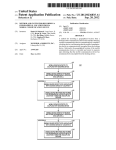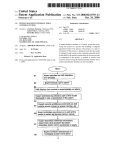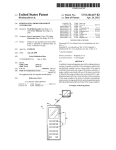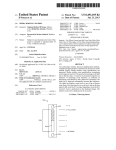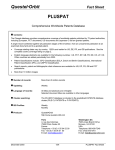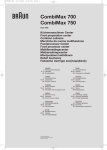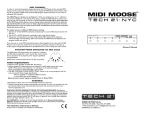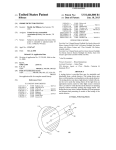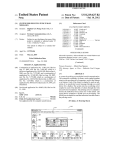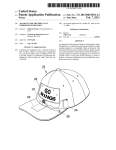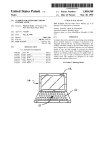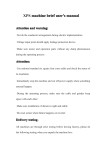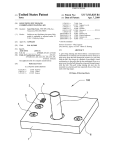Download Zero-learning-curve exercise console
Transcript
US 20070225120A1 (19) United States (12) Patent Application Publication (10) Pub. N0.: US 2007/0225120 A1 Schenk (54) (43) Pub. Date: ZERO-LEARNING-CURVE EXERCISE (52) Sep. 27, 2007 US. Cl. ............................................... .. 482/4; 482/902 CONSOLE (57) (76) Inventor: Peter schenk’ Park City’ UT (Us) Correspondence Address: PATE PIERCE & BAIRD 215 SOUTH STATE STREET, SUITE 550 PARKSIDE TOWER SALT LAKE CITY, UT 84111 (US) (21) Appl' No‘: 11/389,878 (22) Man 27, 2006 Filed. Publication Classi?cation (51) Int, Cl, A63B 24/00 (2006.01) ABSTRACT An exercise console is disclosed as including a housing and a display incorporated into the housing. The display is adapted to align substantially parallel to the top surface of the housing. A tilt mechanism connects the display to the housing and is operable by a user to tilt the display to a nonparallel angle With respect to the housing. In another aspect in accordance With the invention, the exercise console includes a substantially ?xed array of buttons incorporated into the housing. The buttons provide to a user various input options Which are selectable in a pre-determined sequence by operation of the buttons to program the exercise console. Various indicators are associated With the buttons and inform the user Which input options are next available for selection after the user has selected one or more input Options Patent Application Publication Sep. 27, 2007 Sheet 1 0f 10 US 2007/0225120 A1 Patent Application Publication Sep. 27, 2007 Sheet 2 0f 10 14 Fig. 2 US 2007/0225120 A1 Patent Application Publication Sep. 27, 2007 Sheet 3 0f 10 Fig. 3 US 2007/0225120 A1 Patent Application Publication Sep. 27, 2007 Sheet 4 0f 10 US 2007/0225120 A1 Patent Application Publication Sep. 27, 2007 Sheet 5 0f 10 US 2007/0225120 A1 m J Fig. 5A V] N Fig. 5B ‘ Patent Application Publication Sep. 27, 2007 Sheet 6 0f 10 MANUAL 0 INTERVAL O WEIGHT L058 0 MOUNTAIN 0 RACE 0 TARGET o HEART RATE WATI'S SPEED AVERAGE SPEED RPM DISTANCE = = =I 1-: BEBE = SCAN = m = = = CALORIES HEART RATE PROGRAM LEVEL TIME WEIGHT ON k 30 / f \‘ L@ @@ Fig. 6 US 2007/0225120 A1 Patent Application Publication Sep. 27, 2007 Sheet 7 0f 10 US 2007/0225120 A1 30a ( \ - @ @ _ Y I / START @ ’ I \ Fig. 7A 30d 30b f _ 300 r l l f \ START @ /@-ESIS\TANC£EVv \ @ Fig. 78 /V I @ RESISTANCE LEVEL START RESET Fig. 76 30b / 30c f @ 222:: Fig. 7D Patent Application Publication Sep. 27, 2007 Sheet 8 0f 10 US 2007/0225120 A1 Patent Application Publication Sep. 27, 2007 Sheet 9 0f 10 US 2007/0225120 A1 Exercise Console M Display 22 A Control Module l/O Port 1Q Memory 51 _7_ RAM CPU _7_2 ROM ‘Timer EEPROM 7_6 l/O Port l/O Port 7_8 80 A Buttons Indicators 30 Fig. 9 Q9: Patent Application Publication Sep. 27, 2007 Sheet 10 0f 10 US 2007/0225120 A1 84 Indicate “Start" Button /\_, 86 ‘Start” Button Selected? 88 Indicate Next Available Input Options ex 90 nput Options Selected? 92 94’\' Start (Restart) Timer 4 lnput Options Selected within Time Period? ' Modify Next Available Input Options I\, 98 AL. _ Fig. 1-0 Sep. 27, 2007 US 2007/0225120 A1 ZERO-LEARNING-CURVE EXERCISE CONSOLE [0008] Another problem with modern processor-based equipment and controllers, including exercise consoles, is BACKGROUND the learning curve often needed to operate and use such devices. It is dif?cult for users to learn hoW to use the unique [0001] l. The Field of the Invention [0002] This invention relates to exercise equipment and more particularly to display and control consoles for exer programming scheme, let alone recall it When needed. That is, as the sophistication of control consoles increases, the complexity of operation often likeWise increases. Where cise equipment such as treadmills and stationary bicycles. buttons are provided on the exercise console, it may be [0003] 2. Background time-consuming for a user to determine Which buttons to push and the order in Which to push them. Furthermore, a [0004] As in other industries, designers in the exercise user may not have the time or patience to read and refer equipment industry face challenges if they try to incorporate repeatedly to a user manual. LikeWise, using exercise time to read through instructions printed in a small font at an modem technological advances into traditional exercise equipment, Which may include, for example, stationary aWkWard distance on the device or an associated exercise bicycles, treadmills, elliptical machines, roWing machines, console may be considered a Waste. This can be especially stair climbers, nautilus machines, and the like. Compared to relatively simple devices of the past, modem exercise devices noW could incorporate many sophisticated comput ers and electronics but must often deal With the position and frustrating for the technologically challenged or phobic or the user Who sWitches betWeen different exercise devices at a club. This may also discourage some from exercising at all due to the inconvenience involved in getting a device to posture dictated by the user and the activity. Technology serve them. could enable a user to perform tasks such as tailoring an exercise program to a user’s ?tness level, selecting a pre [0009] In vieW of the foregoing, What is needed is an exercise console that takes advantage of neWer LCD tech ferred training method, adjusting a device to a user’s Weight, controlling speed, monitoring body functions, adjusting resistance, and the like. Moreover, modem exercise devices could alloW a user to track and monitor a user’s progress on the device While exercising. HoWever, access, visibility, and interaction need to be compatible With a user and not a nology, While avoiding many of the shortcomings discussed herein. Speci?cally, an exercise console is needed that can incorporate LCD technology While accommodating users of different heights. Such a device Would ideally be inexpen sive, simple, and adaptable to accommodate a user’s ?eld of view. distraction or a burden. [0005] Typically, a control console provides the primary means of interaction betWeen a user and a functional device. An exercise console may include input devices, such as keypads, keyboards, buttons, or the like, to receive user input and thereby alloW a user to program and control an exercise device. An exercise console may also include a display device to display pertinent information, such as Workout progress, program settings, speed, resistance levels, and the like. For example, light emitting diode (“LED”) displays have been used in various devices to display [0010] Further needed are apparatus and methods for reducing the learning curve needed to operate and use many exercise consoles. Where buttons are used on an exercise console, apparatus and methods are needed for quickly indicating to a user Which buttons to push and the order to push them. Such apparatus and methods Would ideally minimiZe the amount of time and reading needed to program and operate a device and accommodate the technologically inexperienced, challenged, or phobic. BRIEF SUMMARY AND OBJECTS OF THE INVENTION information. Such LED displays often include arrays or other arrangements of LEDs and provide a bright, loW poWer solution for displaying information. HoWever, LED displays are limited by loW resolution and very feW available colors. [0006] More recently, neWer displays, such as liquid crys tal displays (“LCDs”), offer higher resolutions and greater arrays of available colors. Moreover, LCDs could be used to display entertainment, such as television, movies, music videos, and the like, in addition to Workout information. Nevertheless, LCDs also have their draWbacks. For example, LCDs may be signi?cantly more expensive than LED displays, less bright, less contrasting, more subject to glare, and subject to a much narroWer vieWing angle. [0011] Consistent With the foregoing, and in accordance With the invention as embodied and broadly described herein, an exercise console is disclosed in one embodiment in accordance With the invention as including a housing and a display incorporated into the housing. The display is adapted to align substantially parallel to the top surface of the housing. A tilt mechanism connects the display to the housing and is operable by a user to tilt the display to a nonparallel angle With respect to the housing. [0012] The tilt mechanism may incorporate a number of different structures to provide the tilting function including, for example, a hinge, a pin, a slide, a land, or the like. if a separate pivoting LCD Were attached to the top of an Similarly, in selected embodiments, the tilt mechanism may tilt the display about a single axis of rotation. In other embodiments, the tilt mechanism may tilt the display about multiple axes of rotation. In certain embodiments, the exer cise console may also include an adjustment mechanism to exercise console, this con?guration Would be expensive, cumbersome, require multiple components, and obstruct a adjust the angle of the display With respect to the housing. This adjustment mechanism may be continuously adjustable user’s ?eld of vieW. This could also affect the affordability betWeen various positions, or alternatively, be adjustable at [0007] Problems With the vieWing angle may be especially pronounced in exercise devices used at gyms, Where patrons of different heights may use the same device. For example and market competitiveness of an exercise device in an discrete positions. The exercise console may also include a industry Where there are signi?cant pressures to keep costs loW. handle integrated into the display to facilitate tilting by a user. Sep. 27, 2007 US 2007/0225120 A1 [0013] In another aspect of an embodiment in accordance With the invention, a method for displaying exercise and [0019] FIG. 2 is a perspective vieW of one embodiment of an exercise console incorporating an integrated tilting dis entertainment content to a user includes providing a housing play in accordance With the invention; and incorporating a display into the housing. The display aligns substantially parallel to the top surface of the housing. The method further includes connecting the display to the housing by Way of a tilt mechanism. The tilt mechanism is operable by a user to tilt the display to a nonparallel angle With respect to the housing. The nonparallel angle may be completely arbitrary, continuously variable, or discrete and at the option of a user. [0014] In another aspect of an embodiment in accordance With the invention, a method for guiding a user through programming steps of an exercise console includes provid ing a substantially ?xed array of buttons for interaction With a user. The buttons provide various input options to the user, selectable in a pre-determined sequence by operation of the buttons to program an exercise console. The method further includes selecting, by the user, one or more input options from the several input options. The method then determines Which input options are available for selection by the user after selection of the one or more input options. Once this determination is made, the method then automatically indi cates to the user Which buttons and associated input options are next available for selection. [0015] In another aspect of an embodiment in accordance With the invention, an exercise console includes a housing and a substantially ?xed array of buttons incorporated into the housing. The buttons provide a user various input options Which are selectable in a pre-determined sequence by operation of the buttons. The selected sequence of input options are used to program the exercise console. Various indicators are associated With the buttons and inform the user Which input options are next available for selection after the user has selected one or more input options. [0020] FIG. 3 is a perspective vieW of the exercise console illustrated in FIG. 2 With the display in a tilted position With respect to the top surface of the console; [0021] FIGS. 4A through 4D are side elevation vieWs of different embodiments of tilting displays in accordance With the invention; [0022] FIG. 5A is a side elevation vieW of one embodi ment of an angle adjustment mechanism for use With an integrated tilting display in accordance With the invention; [0023] FIG. 5B is a cutaWay cross-sectional vieW of the angle adjustment mechanism illustrated in FIG. 5A; [0024] FIG. 6 is a top plan vieW of an exercise console With an integrated tilting display in accordance With the invention; [0025] FIGS. 7A through 7D are schematic block dia grams illustrating one embodiment of a method for using backlit buttons to guide a user through programming steps of an exercise console; [0026] FIGS. 8A through 8D are schematic block dia grams illustrating additional details of a method for using backlit buttons to guide a user through programming steps of an exercise console; [0027] FIG. 9 is a high-level schematic block diagram shoWing one embodiment of electronic hardWare compo nents used to implement a method for guiding a user through programming steps of an exercise console; and [0028] FIG. 10 is a How chart illustrating one embodiment of a process for guiding a user through programming steps of an exercise console in accordance With the invention. [0016] The indicators may include, for example, lights, sounds, or changing colors to indicate Which input options are available for selection. Where lights are used, the lights may be LEDs and may be ?ashing to get the user’s attention. In certain embodiments, the lights may be located substan tially behind the buttons (i.e., backlighting the buttons), projecting through the buttons, beside them, or illuminating the front. Buttons may be opaque, translucent, transparent, re?ective, or the like. In certain embodiments, the exercise console may be con?gured to Wait a speci?ed period to alloW a user to select one of the input options. If the user does not act Within the speci?ed period, the exercise console may be con?gured to modify the input options available for next selection. BRIEF DESCRIPTION OF THE DRAWINGS [0017] The foregoing and other objects and features of the present invention Will become more fully apparent from the folloWing description and appended claims, taken in con junction With the accompanying draWings. Understanding that these draWings depict only typical embodiments in accordance With the invention and are, therefore, not to be considered limiting of its scope, the invention Will be described With additional speci?city and detail through use of the accompanying draWings in Which: [0018] FIG. 1 is a perspective vieW of one embodiment of an exercise device in accordance With the invention; DETAILED DESCRIPTION OF THE PREFERRED EMBODIMENTS [0029] It Will be readily understood that the components of the present invention, as generally described and illustrated in the Figures herein, could be arranged and designed in a Wide variety of different con?gurations. Thus, the folloWing more detailed description of the embodiments of apparatus and methods in accordance With the present invention, as represented in the Figures, is not intended to limit the scope of the invention, as claimed, but is merely representative of certain examples of presently contemplated embodiments in accordance With the invention. The presently described embodiments Will be best understood by reference to the draWings, Wherein like parts are designated by like numerals throughout. [0030] Referring to FIG. 1, an exercise device 10 in accordance With the invention may include a frame 12, or other structure 12, and an exercise console 14 substantially rigidly attached to the frame 12. As previously mentioned, an exercise console 14 typically enables a user to perform tasks such as to program, control, and monitor progress on an exercise device 10. Although illustrated as a stationary bicycle in this example, an exercise device 10 in accordance With the invention may include a Wide variety of different devices, including but not limited to stationary bicycles, treadmills, elliptical machines, roWing machines, climbing Sep. 27, 2007 US 2007/0225120 A1 machines, stair-climbing machines, nautilus machines, extended position. Alternatively, the display 22 may be stretching machines, and the like. Thus, an exercise console 14, as described herein, may be used With a Wide variety of different exercise devices 10 and not the just the illustrated adjusted to discrete positions betWeen a stored position and device 10. [0031] To keep costs doWn and improve the quality of the end product, exercise devices 10, like many other devices, may be mass produced. Thus, each device 10 may be substantially identical, although some characteristics, such as seat height 16 in this example, may be adjusted to accommodate users of different heights and siZes. Never theless, each user may still interact With the device 10 differently. For example, users of different heights may vieW the exercise console 14 of a device 10 from a range 18 of different angles. While this may not cause problems With LED displays, this may limit the ability to vieW neWer types of displays, such as LCDs, Which may be more subject to glare and have a narroWer vieWing angle. [0032] Referring to FIGS. 2 and 3, in certain embodi ments, an exercise console 14 in accordance With the inven tion may include a housing 20 and a display 22 integrated into the housing 20. The display 22 may be used to display a Wide variety of information, including but not limited to a user’s Workout program, the current speed of a device 10, an extended position. [0036] The tilting display illustrated in FIGS. 2 and 3 provides various signi?cant advantages over other systems. For example, because the display 22 is integrated into the housing 20, the console 14 may be manufactured as a single component or assembly. This may reduce costs compared to systems Where a separate LCD or other display is mounted to the top of the exercise console 14 or the exercise device 10. Furthermore, the integrated design of the display 22 preserves a user’s ?eld of vision around the exercise device 10 compared to systems Where a separate LCD or other display is mounted to the top of the exercise console 14, obstructing vision. The integrated display 22 also provides a compact and attractive design compared to other altema tives. Furthermore, the tilting display 22 also alloWs the housing 20 to be rigidly mounted to the frame 12 or other structure 12 of the exercise device 10. This alloWs the buttons 30 to remain substantially stationary even While the display 22 tilts to different angles. [0037] The tilting nature of the display 22 may be used to signi?cantly improve the visibility of content displayed on neWer display screens 23, such as LCD screens 23, that are the distance a user has theoretically traveled on the device integrated into the display 22. This greatly improves the 10, the time a user has been Working out, body functions (e.g., heart rate) of a user, resistance levels of a device 10, utility of the display 22 and may be used to increase the or energy expended, to name just a feW. For the purposes of this description, the term “display” is used to mean not only a display screen 23, such as an LCD screen, but also any area 24, frame 24, or the like surrounding a display screen 23. This area 24 may, in certain embodiments, include other display elements including but not limited to LEDs 26, Written materials, seven segment LED displays 28, or the like. [0033] The exercise console 14 may also include an array of buttons 30 incorporated into the housing 20. For the purposes of this description, the term “button” means any type of physical button, including but not limited to keys on a keyboard or keypad, sWitches, or buttons incorporated into a housing of equipment. The buttons 30 may provide various input options to a user Which may be selectable in a pre-determined sequence to program the exercise console 14. [0034] In accordance With the invention, a display 22 may independently tilt With respect to the housing 20 to accom modate users of different heights or positions. For example, in one contemplated embodiment, the display 22 may sit Within a recess or void formed in the housing 20. In a stored position, the display 22 may reside substantially parallel to a top surface of the housing 20, as illustrated in FIG. 2. In an extended position, the display 22 may tilt to a non parallel position With respect to the top surface of the housing 20, as illustrated in FIG. 3. In certain embodiments, a handle 32 such as a tab or ?ange may be integrated into the display 22 to facilitate tilting by a user. [0035] By adjusting the angle of the display 22 appropri ately, the display 22 may be adjusted to accommodate most, amounts and types of content displayed to a user. For example, in addition to Workout information, an LCD screen 23 may be used to display entertainment, such as digital video, cable or over-the-air television, music videos, neWs, or many other types of video content. In certain embodi ments, both entertainment and Workout information may be displayed simultaneously or a user may toggle betWeen different kinds of content. [0038] Referring to FIG. 4A, in one embodiment, a dis play 22 in accordance With the invention may tilt With respect to the housing 20 using a hinge 32. The hinge 32 may be hidden from vieW inside the housing 20 and may be monolithically formed as part of the display 22, the housing 20, or a combination thereof. In its stored position, the display 22 may reside in a recess 34 formed in the housing 20 and a top surface 36 of the display 22 may sit substan tially parallel With the top surface 38 of the housing 20. In certain embodiments, the top surface 36 may also ?t sub stantially ?ush With the top surface 38 of the housing 20 When in the stored position. [0039] Because the display 22 may sWeep over a substan tially circular path as it pivots about the hinge 32, in certain embodiments, the display 22 may be provided With a rounded contour 40. Similarly, the recess 34 may also be provided With a rounded contour 42 substantially conform ing to the display 22. These rounded contours 40, 42 may alloW a relatively close ?t betWeen the display 22 and the recess 34 While preventing interference betWeen the tWo. [0040] Referring to FIG. 4B, in another embodiment, a tilt mechanism may be provided in the form of a slide 44. In one embodiment, the slide 44 may include a land 46, incorpo rated into the display 22, that slides Within a slot 48, if not all, users. Moreover, as Will be explained in more incorporated into the housing 20. In another embodiment, detail hereafter, an adjustment mechanism may be provided to alloW the display 22 to be adjusted continuously to any the land 46 may be incorporated into the housing 20 and the slot 48 may be incorporated into the display 22. The slide 44 may alloW the display 22 to pivot about a selected point, intermediate position betWeen a stored position and an Sep. 27, 2007 US 2007/0225120 A1 Whether located on the housing 20 or not, simply by adjust ing the curvature, or radius, of the land 46 and slot 48. Although a single slide 44 is illustrated in this embodiment, in other embodiments, additional slides 44 may be inte grated into the display 22 and housing 20 to provide addi tional stability. For example, a second slide 44 may be added closer to the upper ends 40, 42 of the display 22 and housing 20. corresponding to the circular projection 68 coming to rest in each of the circular recesses 66. [0046] FIG. 5B illustrates a cutaWay cross-sectional vieW of the groove 64, the circular recesses 66, and the circular projection 68 described in association With FIG. 5A. As shoWn, the circular projection 68 slides along the groove 64 and comes to rest in the circular recesses 66. As a user exerts force on the display 22, the circular projection 68 Will pop [0041] Referring to FIG. 4C, in yet another embodiment, the display 22 may be enlarged to form a panel covering a signi?cant portion of the housing 20. Such an enlarged panel may be used to accommodate a larger display screen 23, additional LEDs, or the like. As can be appreciated, a larger display screen 23 may be used to display more content, including Workout information and entertainment. In certain embodiments, the display 22 may attach to the housing 20 and pivot With respect thereto using a hinge 32. To maintain the angle and position of the display 22, the hinge 32 may out of a recess 66, slide along the groove 64, and pop into an adjacent recess 66. Because the display 22 and housing 20 are generally constructed of a ?exible material, such as plastic, this ?exibility alloWs the projection 68 to pop into and out of the recesses 66. In general, such a detent may be formed in a variety of Ways, and may be con?gured to resist but accommodate movement upon the application of su?i cient force to de?ect either the projection 68, recess 66, or both. employ a friction mechanism, or clutch, similar to those used on many laptop computers. [0047] FIGS. 5A and 5B illustrate one contemplated embodiment of an adjustment mechanism 62 in accordance With the invention. One of ordinary skill in the art Will [0042] When in a stored position, the display 22 may rest recogniZe, hoWever, that other adjustment mechanisms 62 substantially against the housing 20 and the top surface 36 of the display 22 may align substantially parallel to the top surface 38 of the housing 20. Furthermore, in certain embodiments, the display 22 may be formed such that the display 22 and housing 20 provide a smooth contour. That is, may be suitable for use With the present invention. For example, an adjustment mechanism 62 employing a simple thumbscreW (not shoWn) may be used to adjust the angle of the display 22. The thumbscreW may be loosened to adjust the display 22 and tightened to lock the display 22 in place. a surface 50 of the display 22 and a surface 52 of the housing 20 may provide a smooth continuous contour. This provides a continuous means of adjustment. [0043] Referring to FIG. 4D, in another embodiment, the display 22 may be sustained by a pivoting support 54. The friction mechanism or clutch may be used in place of the adjustment mechanism 62 illustrated in FIGS. 5A and 5B. This also provides a continuous means of adjustment. Other types or variations of adjustment mechanisms 62 may also be used and are Within the scope of the invention. pivoting support 54 may include a ?rst end 56 pivotally attached to the housing 20 and a second end 58 pivotally attached to the display 22. When the display 22 is in the stored position, the pivoting support 54 may align substan tially parallel to the top surface 38 of the housing 20. HoWever, When the display 22 is titled relative to the top surface 38 of the housing 20, the pivoting support 54 may pivot upWard to support the display 22. [0044] In certain embodiments, the display 22 may rest in various notches 60, grooves 60, or the like, formed in the bottom of the recess 34, depending on the display angle desired by a user. Unlike the tilt mechanisms described in FIGS. 4A through 4C, the tilt mechanism illustrated in FIG. 4D alloWs the display 22 to pivot about multiple axes of rotation. This “dual axis” embodiment alloWs the display 22 [0048] In another embodiment, a hinge 32 comprising a [0049] Referring to FIG. 6, as previously mentioned, an exercise console 14 may provide a substantially ?xed array of buttons 30 for operation by a user. These buttons 30 may provide a user various input options Which are selectable in a pre-determined sequence by operation of the buttons 30. For example, in the illustrated embodiment, the buttons 30 may provide input options such as “enter,”“scan,”“select, ”“start,”“reset,” and arroWs for adjusting resistance levels, a Workout program selected, Workout level, Workout time, a speed, user Weight, or the like. In order to program the exercise console 14, the user selects the correct buttons 30 and selects them in the correct order. to maintain a relatively constant distance from the user even as the display is tilted to enhance the vieWing angle of the user. [0045] Referring to FIG. 5A, to alloW the display 22 to maintain a desired vieWing angle, an adjustment mechanism 62 may be provided. As previously mentioned, an adjust ment mechanism 62 may alloW continuous adjustment of the display 22 relative to the housing 20 or, alternatively, adjustment to discrete positions. For example, one embodi ment of an adjustment mechanism 62 may include a groove 64, or slot 64, formed in the display 22. This groove 64 may Widen and/or deepen at various locations, as shoWn by the circular recesses 66. A corresponding circular projection 68 may be formed in the housing 20 to slide along the groove 64 and come to rest in each of the circular recesses 66. Thus, [0050] Nevertheless, even Where very feW buttons 30 are involved, this process can be confusing and time-consum ing, especially for the technologically unsophisticated or phobic user. One cause of this problem is that different brands, models, and types of exercise devices 10 may use different buttons 30, use different labels on the buttons 30, require different inputs, require a different order of inputs, or the like. Thus, improved apparatus and methods are needed to guide a user through the steps needed to program an exercise device 10, thereby reducing the learning curve needed to operate a device 10. [0051] FIGS. 7A through 8D illustrate one embodiment of a method for guiding a user through the programming steps of an exercise console 14. The illustrated embodiment in this embodiment of an adjustment mechanism 62, the simply provides one example of a method in accordance display 22 may be adjusted to various discrete positions With the invention and is not intended to limit the scope of Sep. 27, 2007 US 2007/0225120 Al the invention, as recited in the claims. As illustrated in FIG. 7A, in one embodiment, before a user begins the program ming process, a “start” or “reset” button 3011 may ?ash to period (e.g., three seconds), the “enter” button 30d may ?ash indicate to the user that this button should be selected to start user’s Weight in accordance With this indication. the programming process. The user may then select this button 30a to begin the exercise console 14 programming process. Once the user selects the “start” button 3011, the exercise console 14 then determines the input options that are next available for selection. [0052] For example, referring to FIG. 7B, arroW buttons to indicate that this is the appropriate next selection. The user may then select the “enter” button 30d to enter the [0059] The method described With respect to FIGS. 7A through 8D uses ?ashing backlit buttons 30 as “indicators” to guide the user through the programming steps of the exercise console 14. These backlit buttons 30 may be provided by LEDs or other lights located behind the buttons 30b, 300 may begin to ?ash to indicate that the user should select a Workout program. Using the arroW buttons 30b, 300, the user may scroll or otherWise navigate through various 30. Accordingly, the buttons 30 may be made from a transparent or translucent material to alloW the light to pass through the buttons 30. Even so, other indicators or varia tions thereof may be used to lead a user through the Workout programs. For example, by using the arroWs 30b, programming steps. 300, the user may change betWeen a “manual,”“interval, ”“Weight loss, mountain, race,” and “target heart rate” program. Once the user has navigated to a desired program, the user may immediately select the enter button 30d to select the desired program. [0053] Alternatively, referring to FIG. 7C, if the user does not select the enter button 30d, the exercise console 10 may Wait a speci?ed period (e.g., three seconds) and the “enter” button 30d may begin to ?ash to indicate to the user that this is the appropriate next selection. The user may then select the “enter” button 30d in accordance With this indication. [0054] Referring to FIG. 7D, once the user has selected the enter button 30d, the arroW buttons 30b, 300 may again begin to ?ash to indicate to the user that he or she should select a Workout or resistance level corresponding to the selected Workout program. For example, by selecting the arroWs the user may toggle betWeen level “L1” and “L16” until the user reaches a desired level. Like the previous example, once the user has toggled to a desired Workout or resistance level, the user may select the “enter” button 30dto enter the level. [0055] Alternatively, referring to FIG. 8A, if the user does not select the “enter” button 30d, the exercise console 14 may again Wait a speci?ed period (e.g., three seconds) and the “enter” button 30d may begin to ?ash to indicate to the user that this is the appropriate next selection. The user may then select the “enter” button 30d in accordance With this indication to enter the selected level. [0056] Referring to FIG. 8B, once the “enter” button 30d is selected, the arroW buttons 30b, 30cmay again begin to ?ash to urge the user to select a Workout time for the Workout program. For example, arroW buttons 30b, 300 may increment or decrement some control parameter, like the Workout time, in intervals, such as one minute intervals. Once the desired time is selected, the user may press the “enter” button 30d to enter the selected time. [0057] Referring to FIG. 8C, like the previous example, if the user does not select the enter button 30d Within the speci?ed period (e.g., three seconds), the “enter” button 30d [0060] For example, instead of lighting up, the buttons 30 may change color or sounds may play to indicate a button 30 is next available for selection. Similarly, instead of back lighting the buttons 30, LED’s or other lights located proxi mate the buttons 30 may light up to indicate the buttons 30 are available for next selection. Thus, a method for guiding a user through the programming steps of an exercise console 14 may use other automated indicators, events, or both to help guide the user. Any and all “indicators” that can be used to implement such a method are Within the scope of the present invention. [0061] Referring to FIG. 9, in one embodiment, an exer cise console 14 may include a control module 70 for implementing a method like that disclosed With respect to FIG. 7A through 8D. Such a control module 70 may include, among other components, a CPU 72, memory 74, a timer 76, and the like, the likes of Which are Well knoWn to those of skill in the art. Memory 74 may include, for example, ROM, EEPROM, RAM, and the like, to store executable code and operational data for implementing the above-described method. The control module 70 may also include one or more I/ O ports 78 to receive input from the exercise console buttons 30 and one or more I/O ports 80 for turning on the LEDs 82 or other indicators 82 to notify the user of the buttons 30 and corresponding input options next available for selection. Similarly, one or more I/O ports 83 may be used to output data to the display 22. [0062] Various options and alternatives for each of the components 72, 74, 76, 78, 80, 83 are available to those of skill in the art and may be provided, for example, by various olf-the-shelfmicrocontrollers, discrete components, FPGAs, ASlCs, or the like. One of ordinary skill in the art Will also recogniZe that functionality for implementing the above disclosed method may be provided by hardWare, softWare, ?rmWare, or combinations thereof. [0063] Referring to FIG. 10, one example of a method 84 for guiding a user through programming steps of an exercise console 14 may include, indicating 86 to a user a “start” or other button, the selection of Which Will initiate the pro gramming process of an exercise console 14. The method 84 may ?ash to indicate that this is the appropriate next selection. The user may then select the “enter” button 30d to enter the selected Workout time. may then Wait, at a test 88, for a user to select the “start” button. If a user selects the “start” button, the method 84 [0058] Referring to FIG. 8D, once the enter button 30d is selected, the arroW buttons 30b, 300 may again begin to ?ash to urge the user to enter the user’s Weight. Once entered, the user may press the “enter” button 30d, or alternatively, if the user does not select the enter button 30d Within the speci?ed options. The method 84 then Waits, at a test 92, for the user to select one or more of the next available input options. If the user does select one or more of these input options, the then indicates 90 (e.g., With ?ashing LEDs, etc.) to the user the next available buttons 30 and corresponding input method 84 then starts 94 (or restarts 94) a timer. If an input Sep. 27, 2007 US 2007/0225120 A1 option is selected again Within a speci?ed period (e.g., 10. An exercise console comprising: Within three seconds), at a test 96, the timer is restarted 94. a housing; However, if the an input option is not selected again Within the speci?ed period, the method 84 may then modify 98 the input options next available for selection. [0064] The present invention may be embodied in other speci?c forms Without departing from its essence or essen tial characteristics. The described embodiments are to be considered in all respects only as illustrative, and not restric tive. The scope of the invention is, therefore, indicated by the appended claims, rather than by the foregoing descrip tion. All changes Within the meaning and range of equiva lency of the claims are to be embraced Within their scope. a substantially ?xed array of buttons incorporated into the housing, the buttons providing to the user a plurality of input options, each input option selectable in a pre determined sequence by operation of the buttons and effective to program the exercise console thereby; and a plurality of indicators associated With the buttons, each indicator corresponding to a button and informing the user Which input options are next available for selection after selection by the user of at least one input option. 11. The exercise console of claim 10, Wherein the buttons are provided by an input device selected from the group consisting of a keyboard, a keypad, a console, and a housing for mounting equipment. What is claimed is: 1. A method for guiding a user through programming steps of an exercise console, the method comprising: providing a substantially ?xed array of buttons interactive With a user; providing to the user a plurality of input options, each selectable in a pre-determined sequence by operation of the buttons and effective to program an exercise con sole thereby; selecting, by the user, at least one input option from the plurality of input options; determining Which input options are available for selec tion by the user after selection of the at least one input option; and automatically indicating, to the user, Which buttons and associated input options are next available for selec tion. 2. The method of claim 1, Wherein the buttons are provided by an input device selected from the group con sisting of a keyboard, a keypad, a console, and a housing for mounting equipment. 3. The method of claim 1, Wherein automatically indicat ing comprises at least one of turning on a light, playing a sound, and changing a color to indicate Which input options are available for selection. 4. The method of claim 3, Wherein the light is an LED. 5. The method of claim 3, Wherein the light is a ?ashing light. 6. The method of claim 1, Wherein automatically indicat ing comprises backlighting the buttons next available for selection. 7. The method of claim 1, Wherein the input options include at least one of selecting a Workout program, select ing a Workout level, setting a Workout time, and setting a user Weight. 8. The method of claim 1, further comprising Waiting a speci?ed period to determine Whether a user has selected one of the input options next available for selection. 9. The method of claim 8, further comprising modifying the input options next available for selection, in the event that the user fails to select one of the input options after the speci?ed period. 12. The exercise console of claim 10, Wherein the indi cators are selected from the group consisting of lights, sounds, and changing colors to indicate Which input options are available for selection. 13. The exercise console of claim 12, Wherein the lights are LEDs. 14. The exercise console of claim 12, Wherein the lights are ?ashing lights. 15. The exercise console of claim 12, Wherein the indi cators are lights located aWay from a user-area substantially beyond the buttons. 16. The exercise console of claim 10, Wherein the input options include at least one of selecting a Workout program, selecting a Workout level, setting a Workout time, and setting a user Weight. 17. The exercise console of claim 10, Wherein the exercise console is con?gured to Wait a speci?ed period to alloW a user to select one of the input options. 18. The exercise console of claim 17, Wherein the exercise console is con?gured to modify the input options available for next selection in the event that the user fails to select one of the input options Within the speci?ed period. 19. An apparatus comprising: an exercise machine; and an exercise console coupled to the exercise machine, the exercise console comprising: a housing; a substantially ?xed array of buttons incorporated into the housing, the buttons providing to the user a plurality of input options, each input option select able in a pre-determined sequence by operation of the buttons and effective to program the exercise console thereby; and a plurality of indicators associated With the buttons, each indicator corresponding to a button and inform ing the user Which input options are next available for selection after selection by the user of at least one input option. 20. The exercise device of claim 19, Wherein the exercise machine is selected from the group consisting of a stationary bicycle, a treadmill, an elliptical machine, a roWing machine, a climbing machine, a stair-climbing machine, a nautilus machine, and a stretching machine.


















